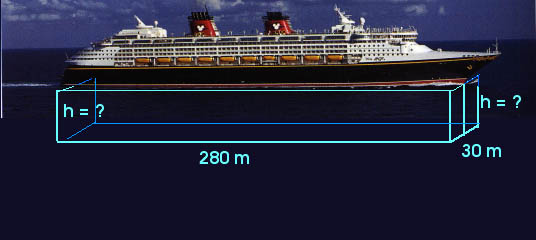




We will make the approximation that the ship's hull underwater is a rectangular solid with length ofL = 280 m and a width of
w = 30 m and a "draft" or depth of h
That means the volume of water that is displaced is
V = L w h = (280 m) (30 m) h V = (8400 m2) h
This volume of sea water has a mass of
M = V
Mwater = (1025 kg/m3) (8400 m2) h
Mwater = ( 8,610,00 kg/m ) h
Mwater = ( 8.61 x 10 6 kg/m ) h
There will be an m, for meters, in h. That is, h will be so many meters. That means that Mwater will, indeed, be measured in units of kg, kilograms.
Be careful now. This is a mass. We know weight is a force and will be measured in units of Newtons. However, we are given that the Magic's displacement or weight is 77,000 metric tons. A metric ton is the weight of 1,000 kg (or 1,000 kg-wt). That is the weight of
77 x 106 kg or
W = (77 x 106 kg) g The bouyant force is
Fbouy = Wwater Fbouy = Mwater g
Now set the bouyant force equal to the weight of the vessel,
Fbouy = Mwater g = (77 x 106 kg) g = W Mwater g = (77 x 106 kg) g
Mwater = (77 x 106 kg)
This mass of the water is determined by the volume,
Mwater = V
We have already evaluated this,
Mwater = ( 8.61 x 10 6 kg/m ) h Mwater = ( 8.61 x 10 6 kg/m ) h = (77 x 106 kg)
h = (77 x 106 kg) / (8.61 x 10 6 kg/m)
h = 8.9 m
Remember, we used some reasonable approximations. The actual "draft" or depth is about 7.7 m.
(c) 2000, Doug Davis; all rights reserved.